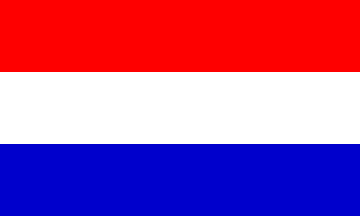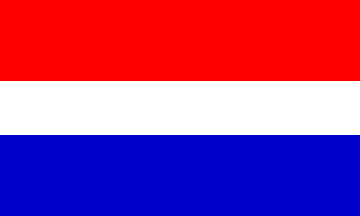
Last modified: 2024-11-23 by daniel rentería
Keywords: paraguay | seal | phrygian cap | different reverse | treasury | lion | star: 5 points (yellow) | simplification | stylization | license plate |
Links: FOTW homepage |
search |
disclaimer and copyright |
write us |
mirrors
The Obverse (front) |
The Reverse (back) |
|
image by
Zoltán Horváth, 27 August 2024
|
image by
Zoltán Horváth, 27 August 2024
|
TYPE: National flag and ensign.
USAGE: ![]()
RATIO: 11:20
FIS: ![]() (Two Sided: obverse and reverse are different)
(Two Sided: obverse and reverse are different)
ADOPTED: 1842
LAST MODIFIED: 15 July 2013 (by decree)
See also:
The flag of Paraguay is a vertical tricolor of red, white, blue. On the obverse (front) side, the centre of the white fess is charged by the national coat of arms. This consists of a yellow Star of May, recalling the month of independence in 1811, which is surrounded by a wreath and the full name of the state, "REPÚBLICA DEL PARAGUAY," (Republic of the Paraguay). In the same position on the reverse, it is charged by the coat of arms of the treasury: a lion facing east, holding a staff on which a Phrygian Cap (liberty cap) is placed; above it is an inscription "PAZ Y JUSTICICA" or "Peace and Justice". The ratio and both emblems have been modified several times, most recently on 15 July 2013. Paraguay is the only sovereign nation-state whose flag has different charges on each side.
Alex Garofolo, 27 July, 2014
According to Article 5 of the decree, "the geometric proportion of its design and production should be kept as closest as possible to 1:0.55."
Is it so? It makes 11:20 in our usual notation, which is slightly unusual, but not quite odd. It is not far from the previously reported 3:5. What does the previous regulations actually say about the ratioif anything?
Željko Heimer, 24 July 2013
The 2013 law does prescribe specific colors
(PM, CMYK, and RGB), but only for the emblems (on
the flag and elsewhere); for the flag (art.5) it specifies «The
red colour, as well as the blue colour, shall be kept as so-called
“primary colours”, that is, without admixture with other
colours».
António Martins, 19 October 2017
Please compare
these
two
images, created for, and displayed at the official website of the
Paraguayan Presidency: Both
red and blue (but not white) are widely different, [matching] the legal
prescription — flag colors were best specified in a relative,
comparative manner, making use of common words in human language, with
widely accepted meanings.
António Martins, 18 October 2017
The Appendix [of the decree] shows images of the coats of arms and of the seals, with the name of their elements and colours. The colours are prescribed as follows:
The Flag Manual - Beijing 2008 gives Pantone colors: PMS 032 (red), PMS 102 (yellow), PMS 139 (brown), PMS 285 (blue), PMS 355 (green), and PMS Black.
The Album des Pavillons 2000 [pay00] gives approximate colors in Pantone and CMYK systems:
|
|
|
|
|
|
|
|
|
|
|
White, blue and red flags were used by Paraguayan troops in 1806 when
they went to the defense of Buenos Aires during the
British invasion. The earliest mention of a red-white-blue tricolor in
Paraguay seems to date from 15 August 1812.
This bore, on one side the arms of the capital city, Asunción, and on
the other the arms of the King of Spain. The Star of May in the national
arms recalls the date of independence, 14 May 1811. Defense of national
liberty is symbolized by the lion guarding the liberty cap on the Treasury
seal whose motto proclaims «Peace and Justice».
Ivan Sache, 20 October 1999,
quoting [smi75b]
The colors were influenced by French Tricolore,
which had become a symbol of liberation. A number of
variant designs [vd. also
here] existed prior to the current design,
which was regularized in 1842. The practice of having a separate emblem on
each side is dating from the time of José de Francia, in power from
1814-1840.
Ivan Sache, 20 October 1999,
quoting [rya97]
The official symbolism of the flag is very rich. To mention only colour
symbolism, red stands for patriotism, courage, heroism, equality and
justice; white for purity, firmness, union and peace; and blue for
tranquility, love, knowledge, verity and liberty.
Ivan Sache, 20 October 1999,
quoting [eunXX]
.gif)
.gif) images from [1] and
[2] at Wikimedia Commons
images from [1] and
[2] at Wikimedia Commons
The coat of arms was adopted in 1812 (like
the flag)! But it was not precisely described in all its elements.
In 1823 it was modified by Dr. Francia.
It was used even after his death until 1842.
Since 1826 the bishopric Paraguay had
used a differing version. In 1842 the symbols
of Paraguay were described exactly for the first time. We know that the
coats of arms before had looked similar
[a8m86].
Possibly the bishopric had used two trees?
The “makers” of the 1842 arms said nothing about all their
earlier prototypes.
Ralf Stelter, 23 January 2001
The “classical” emblem (used in all flags of 1842-1990), is noted in several variations, of which is most notable difference in the field around the star on the obverse, with three main types:
On the obverse (front) side, the centre of the white fess is charged by the national coat of arms. This consists of a yellow Star of May,
recalling the month of independence in 1811, which is surrounded by a wreath and the full name of the state, "REPÚBLICA DEL PARAGUAY,"
(Republic of the Paraguay). In the same position on the reverse, it is charged by the coat of arms of the treasury: a lion facing east, holding a staff
on which a Phrygian Cap (liberty cap) is placed; above it is an inscription "PAZ Y JUSTICIA" or "Peace and Justice".
Christopher Southworth, 9 October 2024
The flag of Paraguay was altered on 15 July
2013 to show new drawings of the emblems. The front of the flag has the
coat of arms, which has been simplified, and the reverse shows the revised
Treasury arms. The introduction of new arms was one of the last acts of
outgoing President Federico Franco. The drawing of the Paraguay arms has
been altered on at least four occasions over the past 100 years and the
latest change is intended to bring the design closer to its original
form.
Cai Zhenyuan, 02 December 2013
The emblems shown on the flag of Paraguay were amended by decree, adopted by the Executive on 15 July 2013, signed by by the President of the Republic and the Minister of the Interior. The modifications should "reflect the original characteristics of the symbol adopted in 1842". The modifications should be implemented by the official institutions no later than 90 days after the publication of the Decree.
The amendments are presented as a return to basics, here the symbols originally adopted in 1842. Accordingly, the Decrees adopted in 1926 and 1957, which modified the original coats of arms, have been abrogated.
On the obverse of the flag, the red ring surrounding the writing "República del Paraguay", introduced in 1957 by Alfredo Stroessner, will be removed. The writing will be changed from yellow to black. The blue disk surrounding the yellow star will be removed. On the olive branch, the olives will be made plain green instead of green and ochre. Accordingly, the emblem will keep only three colours, black, yellow and green. A proposal to replace the branches of palm and olive by branches of queen palm and yerba mate was turned down.
The reverse of the flag will not be modified, except the colors: ochre for the lion, brown for the spear, red for the Phrygian cap and black for the writing "PAZ Y JUSTICIA".
The writings on the two sides of the flag will use the Arial Black font.
Ivan Sache, 17 July 2013
I found that, at the Opening Ceremony of the Sochi Winter Olympic
Games, Team Paraguay was marching with pre July
2013 flag. It seems Russians did not prepare new flags.
Nozomi Kariyasu, 8 February 2014
When the flag is depicted on smaller items (souvenirs, etc.) sometimes the seal is reduced to a disk or circle; I’ve seen these both blue and black. It depends on the material and the size of the item. If I recall correctly, the circle is more common, but a solid disk version is used on really small items. (Obviously, the disk/circle appears in the white band.) I’ve never seen these simplifications actually used as flags, only as decorations on objects.
Terence Martin, 10 August 2004
 image by António Martins, 16 January 2006
image by António Martins, 16 January 2006
While red/white/blue striping is common as a decorative theme, once a cloth is attached to a stick, it always had the seal on it. It is rarely totally omitted. (My last visit to Paraguay was in 1995, so things may have changed.)
Terence Martin, 04 August 2004
Paraguay introduced new license plates around 2002. They have the flag at upper left and an emblem at upper right. The flag does not have the emblem, it is a plain tricolor. (See photo by Osvaldo Fernández)
Olav Arne Brekke, 30 January 2005
 image by
António Martins-Tuválkin, 21 December 2023
image by
António Martins-Tuválkin, 21 December 2023
In 2017, while browsing Paraguayan government websites, I noticed two separate
instances of flag-inspired graphics that seem to show the national flag with a
visibly thinner white stripe, less than the expected 33.3% of a regular
triband. If it had been just one, I’d ignored it as a designer’s quirk, but two,
clearly unrelated — that’s a trend, behind which there might be something
noteworthy.
The first of
these two uses regular red and 23% thin white stripe, in a stance that
suggests a unfurled but drooping flag on an vertical pole:
https://twitter.com/SNJPy/status
https://www.cleanpng.com/
The other logo uses darker red and 26% thin white stripe, its design
sugesting a flag on an angled pole or staff, unfurled by wind blow:
http://www.ing.una.py/?page_id=28965
https://i0.wp.com/www.ing.una.py/wp-content/uploads/2017/09/transp_logo.png
António Martins-Tuválkin, 21 December 2023